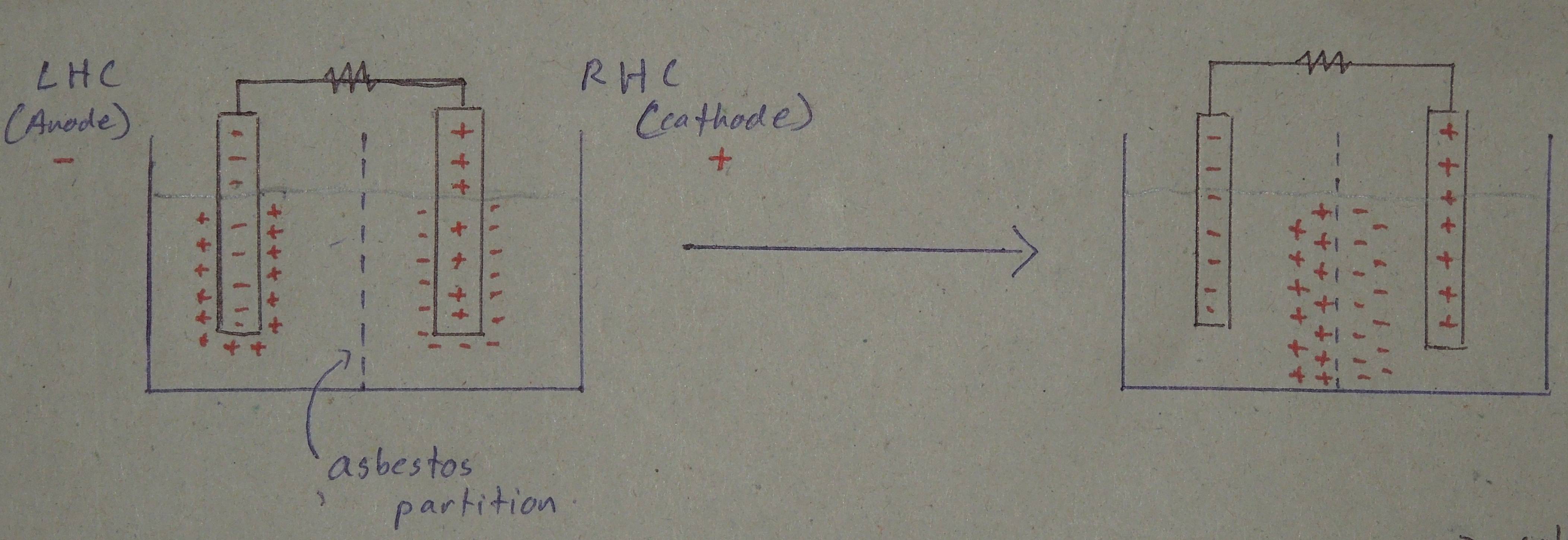We're studying the topic Electrochemistry at school now, and I've got a few doubts regarding electrochemical cells and salt bridges.
What I am going to do is listing out (point-wise) what I understood from class, and then pose my questions (in bold). The logic behind listing out what I understood about the topic beforehand? I've a very strong feeling I'm harboring some serious misconceptions regarding the topic, so if I list out what I do know, then hopefully someone can alert me to an incorrect point, and also correct it.
- LHC - Left half cell (contains the anode, which is negatively charged in electrochemical cells)
- RHC - Right half cell (Contains the cathode, which is positively charged in electrochemical cells)
During the course of the reaction,
In the LHC, metal atoms of the electrode release their electrons to the anode and enter the solution as positive ions.
The positive metal ions, under the influence of the negatively charged anode, accumulate around the anode, resulting in a Solid-Liquid Junction. The Solid-Liquid Junction is also known as the Helmholtz Double Layer.
Similarly in the RHC, negatively charged ions (formed from the electrolyte solution) accumulate around the cathode, resulting in another Solid-Liquid Junction.
It is the potential difference between the LHC and RHC Solid-Liquid Junctions potentials that gives rise to the emf which results in the flow of electrons (electric current) from the LHC to the RHC via the metal wire that connects their corresponding electrodes.
However, as the reaction proceeds, the quantity of positive and negative ions builds up (in the LHC and RHC respectively). So much, that these ions under their mutual attraction, override the force of attraction that binds them to the electrodes and accumulate at the porous asbestos partition that separates the two half cells. This is called the Liquid-Liquid Junction. The formation of the Liquid-Liquid Junction comes at the cost of the Solid-Liquid Junctions, which disintegrate.
As the Liquid-Liquid Junction potential doesn't involve the electrodes, it cannot set up a potential difference across them, therefore no current flows along the wire. This is why an electrochemical cell stops generating current after some time has elapsed.
This problem can be overcome by use of a salt bridge, which in effect, neutralizes the net charges on either side of the asbestos partition, thus releasing the ions back into the solution. These ions are once again attracted by the electrodes, and the two Solid-Liquid Junctions are re-established. So current once again begins flowing through the wire.
I'd appreciate it if anyone could proof-read those points. Also I have doubts whether the Solid-Liquid Junction can also be called the Helmholtz Double Layer. I made these points in class, and I let my teacher go through them, and he's in agreement with them, so I don't think this is a case of talking down the points wrong, at least not with respect to what was mentioned in class.
Now I asked my teacher, Q1: Screw the partition. Why not simply have the two half cells in separate compartments kept at a distance from each other, instead of using a 'partial' barrier like the porous asbestos partition? Wouldn't that eliminate the possibility of a Liquid-Liquid Junction being formed?
His answer: Well they're ions buddy, so they'll attract each other anyway and accumulate at the sides of the compartment, after all....they're charged. So even though that wouldn't result in a Liquid-Liquid Junction, there still wouldn't be any potential difference across the electrodes, so nil current. Plus, if you separate the compartments like that, it'll just take up space; compact electrochemical cells are more convenient to use.
Q2: Is my teacher entirely right here?
And yet again, Q3: Are all the points I've mentioned correct?




